Main Theme
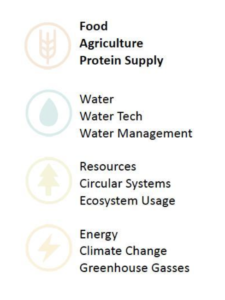
Sub-theme: Carbon Reduction; Biochar; Waste Product; Agricultural Sustainability; Agro-Technology; Carbon Removal Technology
Abstract
With a population of more than 27 million people, Cameroon is a country in Central Africa with a carbon dioxide (CO2) emission per capita of 0.34 metric tons and annual emission of 9.30 million tons as of 2021. These emissions primarily stem from activities such as fossil fuel combustion and cement production. The significant release of CO2 poses a pressing challenge to the nation’s reliance on natural resources and its agricultural sector, which serves as a vital source of livelihood and sustenance. Consequently, there exists an urgent imperative to deploy carbon removal technologies at scale within Cameroon and worldwide.
The utilization of biochar, derived from waste coffee husks sourced from Synergie Nord Sud (SNS), the largest coffee-processing plant in Cameroon, and produced by NetZero, has emerged as a remarkable breakthrough. Biochar production is an age-old agricultural technique that traces its roots back thousands of years to the fertile Terra Preta soils of Brazil. This black powdery substance is generated through the heating of organic materials like wood chips, manure, leaves, and even coffee husks, under oxygen-free conditions (preventing combustion and CO2 emissions) in a process called pyrolysis. NetZero, a climate venture leveraging this ancient “wonder material” to perform long-term carbon removal, extracts carbon from agricultural waste in tropical developing countries, and converts it into a permanent soil amendment (biochar) and electricity. In 2018, the Intergovernmental Panel on Climate Change officially designated biochar as a “negative emissions” technology, recognizing its crucial role in mitigating global warming and limiting temperature rise to 1.5°C above pre-industrial levels, thus offering a pathway to avert catastrophic climate events. With its array of climate benefits such as enhanced soil fertility, generation of green energy, waste reduction, and notably, carbon sequestration from the atmosphere, biochar has the potential to sequester a significant portion of the approximately 10 gigatons of CO2 globally that requires extraction from the atmosphere annually, with estimates ranging from 1.36 to 3 gigatons.
Sustainable Development Goals Chart

Main Highlights
Problem
Cameroon currently exhibits a per capita carbon dioxide emission of 0.34 metric tons and an annual emission of 9.30 million tons as of 2021. The socioeconomic impact of climate change, which is also driven by CO2 emissions, is damaging both the structural poor and the close to 40% of vulnerable households in Cameroon. Nearly 75% of the workers in the informal agricultural sector are women and are worst hit by climate-related issues.
Context
Cameroon is a country found on the Gulf of Guinea and located in Central Africa with a population exceeding 27 million people. Over 40% of the country is covered by tropical forests and this provides an estimated 8 million rural people with traditional staples including food, medicines, fuel, and construction materials.
Solution
Biochar is a negative emission technology, with the capacity to take up 1.36 to 3 gigatons of CO2 out of the estimated 10 gigatons of CO2 that is needed to be removed from the atmosphere each year globally. NetZero, a climate venture leveraging biochar to perform long-term carbon removal, extracts carbon from agricultural waste in tropical developing countries, and converts it into a permanent soil amendment (biochar) and electricity. The company has successfully established Africa’s first industrial-scale biochar production plant located in Nkongsamba in western Cameroon. In this facility, NetZero produces 2,000 tons of biochar each year from waste coffee husks collected, which is then distributed to small scale coffee farmers to cultivate crops, who in turn supply the coffee processing factory with beans. It is a guaranteed carbon removal solution with a global sustainable removal capacity of up to 2 billion tonnes of CO2 equivalent a year.
Impact Statement
The production of biochar plays a pivotal role in diminishing the carbon footprint associated with agriculture. It achieves this by simultaneously extracting carbon from the atmosphere and curbing additional emissions stemming from the application of synthetic fertilizers. This reduction in emissions extends beyond proportionate levels, encompassing greenhouse gas (GHG) emissions from both fertilizer production (CO2) and usage (N2O). The application of biochar on agricultural land enhances the soil by acting as a carbon sponge that effectively retains water and nutrients at plant root level, rebalances soil pH, improves soil aeration and increases crop yield for farmers.
System Perspective
The conversion of what was once considered waste into a negative emissions technology through pyrolysis, offering both carbon removal and sustainable agricultural solutions, represents a truly unique innovation. NetZero’s distinctive operational approach, establishing a circular model that ensures satisfaction and benefits all participants in the agricultural chain, sets an exceptional example and proves highly advantageous for both humanity and the environment. Biochar, a locally produced product, yields significant global impacts, accompanied by substantial socioeconomic benefits.
Case Overview
The global impact of climate change has become a huge cause for concern as it threatens the existence of humans and the environment. In Cameroon, climate change is also an imminent threat to the country’s dependence on natural resources and mostly agriculture for livelihoods and subsistence.
Over 40% of the country is covered by tropical forests, which provides an estimated 8 million rural people with traditional staples including food, medicines, fuel and construction materials. Meanwhile, constant changes in temperature, rain, and droughts are putting these populations at greater risks for increased poverty and famine. Research confirms that net revenues decline when precipitation decreases or temperatures rise across farms in the region. Agriculture in Cameroon frequently faces limitations imposed by seasonality and the availability of moisture. While other physical factors like soil quality and topography undoubtedly influence agriculture, climate remains the predominant factor shaping the range of cultivated crops and the types of agricultural practices employed. In 2021, agriculture contributed around 16.91% to the GDP of Cameroon, and employs nearly 70% of the active population.
With the continued burning of fossil fuel for energy production, industrial activities such as cement production and gas flaring, Cameroon has ranked 30th in the World Bank ranking of African countries on CO2 emissions. Cameroon’s CO2 emission per capita stands at 0.34 metric tons, and the country’s annual CO2 emission stands at 9.30 million tons as of 2021, increasing year on year.
The disastrous impact of CO2 is directly related to the climate change issues experienced by the country in recent years. Asides its effect on natural resources and agriculture, the climate change issues also driven by CO2 emission has resulted in wide-ranging socioeconomic impacts.
For Cameroonians, the socioeconomic impact of climate change shocks is hurting both the structural poor and the close to 40% of vulnerable households in Cameroon. Women, especially those living in conflict areas or indigenous groups, are more severely hit, as they account for 75% of the workers in the informal agricultural sector and are primarily responsible for the welfare of their households and food security.
A Carbon Removal Solution
Biochar is a product made from a wide range of organic matter, provided it is biodegradable and renewable. It is commonly made from agricultural residues used as a feedstock, such as coffee or cocoa husks and shells; sugarcane bagasse; coconut shells and fibers; peanut or cashew shells; and palm empty bunches. These feedstocks are turned into biochar through pyrolysis, a process involving heating up organic matter such as wood chips, manure, leaves, or coffee husks, in the absence of oxygen (in order to prevent combustion, which would emit CO2). It is a thermochemical reaction that breaks down complex molecular chains and rearranges molecular bonds to form a solid, very staple product called biochar.
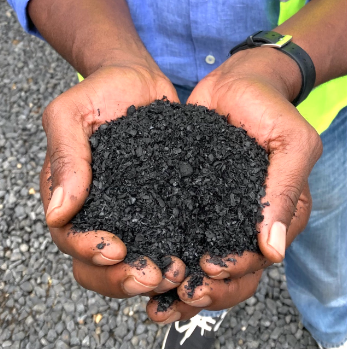
Classified as a negative emission technology, biochar has the capacity to take up 1.36 to 3 gigatons of CO2 out of the estimated 10 gigatons of CO2 that is needed to be removed from the atmosphere each year. While natural carbon removal solutions like trees contribute substantially to CO2 reduction in the atmosphere, research indicates that they alone will not be sufficient. Consequently, biochar stands out as one of the few solutions capable of providing prolonged and assured carbon removal for hundreds of years. With a global sustainable removal capacity of up to 2 billion tonnes of CO2 equivalent annually, biochar offers the most mature solution to be brought at scale with already available technology and supported by strong science-based data.
Biochar for Sustainable Agriculture
Biochar finds extensive application in agriculture as a soil amendment, precisely when mixed with topsoil at the plant root level. Using biochar means storing carbon, captured from the air by plants during photosynthesis, in the soil in an inert solid form. This single application of biochar yields long-lasting agronomic benefits, in contrast to fertilizer which has to be applied annually, raising costs and debt for farmers. The physicochemical characteristics of biochar contribute to enhancing soil quality in several ways.
Firstly, its remarkable porosity significantly improves the water-holding capacity of soils, ensuring adequate moisture availability for plants. Like a sponge, biochar contains many pores that give the carbon-rich material an amazingly high surface area. One gram of biochar can have a surface area of a football field. While biochar does not introduce nutrients to the soil, the negatively charged surface of biochar enables better retention of essential nutrients, promoting their efficient uptake by plants. Furthermore, the high carbon content of biochar aids in rebalancing acidic soils, optimizing pH levels for healthy plant growth. Collectively, these factors culminate in a sustainable enhancement of crop productivity, enabling the potential transition to 100% organic farming practices. Research shows, in tropical soils, high-nutrient biochar inputs stimulated yield substantially more than low-nutrient biochar, where productivity is raised by 25% on average. However, it is important to note, in temperate soils, the application of biochar has no demonstrated effect on crop yield.
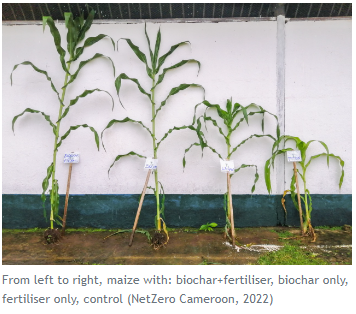
Maize field trials with biochar, fertilizer, and control. Photo Credit: NetZero
NetZero: A Replicable Model
Founded in 2021 by Axel Reinaud, Olivier Reinaud, Pedro de Figueiredo and Aime Njiakin, the French start-up NetZero has a clear mission to scale up the adoption of biochar, one of the few viable solutions for long-term carbon removal from the atmosphere. By operating in tropical regions and capitalizing on the diverse co-benefits of biochar, NetZero’s innovative approach simultaneously addresses three critical challenges in developing nations: climate change, sustainable agriculture, and rural development.
NetZero has successfully established Africa’s first industrial-scale biochar production plant located in Nkongsamba in western Cameroon. Nkongsamba and its surroundings are best known for the country’s largest coffee farms. By harnessing the waste coffee husks produced bySynergie Nord Sud (SNS), the largest coffee-processing plant in Cameroon, these biomass materials are not left to slowly decay in landfills. Instead, they are transported to the NetZero facility where they undergo a transformative process, turning them into a remarkable material with the potential to play a crucial role in climate change mitigation. NetZero aims to replicate this local and circular model in other tropical developing countries, leveraging the abundant availability of locally accessible unused crop residues.
NetZero’s first pilot plant in Nkongsamba produces up to 2,000 tons of biochar each year. These products are distributed to small scale coffee farmers to help improve soil fertility and cultivate crops, who in turn supply SNS’s coffee processing factory with beans.
While the biochar production process brings numerous benefits, it also comes with certain limitations, particularly in terms of high thermal energy consumption. The heating of biomass during pyrolysis can generate flammable gasses, including methane and hydrogen. However, NetZero has devised a model that effectively addresses this challenge. A portion of these gasses is redirected to fuel the oven, thereby providing the necessary heat, while the remaining gasses are converted into renewable electricity distributed to surrounding communities. This strategic approach enables NetZero to manage and utilize the byproduct gasses efficiently within their operations.
One of the core objectives of NetZero is to replicate the model from Nkongsamba on a large scale in order to be able to remove 2 million tons of CO2 from the atmosphere each year by 2030. At COP26 in 2021, the company launched a major partnership with the Government of Cameroon to construct at least 50 biochar production sites in the country before 2030, allowing to remove from the atmosphere at least 250,000 tonnes of CO2 every year. The company is working with the Earthworm Foundation to deliver field training and education to farmers about the co-benefits of using biochar in place of synthetic fertilizers.
In April of 2023, NetZero opened a facility in Brazil with a capacity of 5,000 tons per year, making it the largest biochar facility in the world using crop residues. This will remove the equivalent of more than 6,500 tons of atmospheric CO2, while bringing a durable fertilization solution for agriculture. Before the end of 2023, NetZero will build two other production plants in Brazil, leveraging its unique model to bring biochar at scale.
NetZero has achieved exceptional recognition, most notably: the Milestone Award in Elon Musk’s XPRIZE Carbon Removal competition, the ‘Efficient Solution’ label by the Solar Impulse Foundation, the Green Tech prize from Tech for Good Awards, and a certified carbon-removal project under the Puro Standard. Compliance to Puro.earth methodology requirements is done by an independent assessor. Their auditor visits the production facility, validates the accuracy of data, including the carbon net-negativity evidence presented in a Life Cycle Assessment (LCA) or Environmental Product Declaration (EPD) report, and issues an audit statement. The Puro Standards certifies bio-based carbon credits awarded to NetZero, which are then purchased by companies seeking to offset their emissions. This offers potential for businesses and investors to channel resources towards effective carbon removal solutions, while also enabling NetZero to scale up its biochar facilities and expand its operations into other tropical regions.
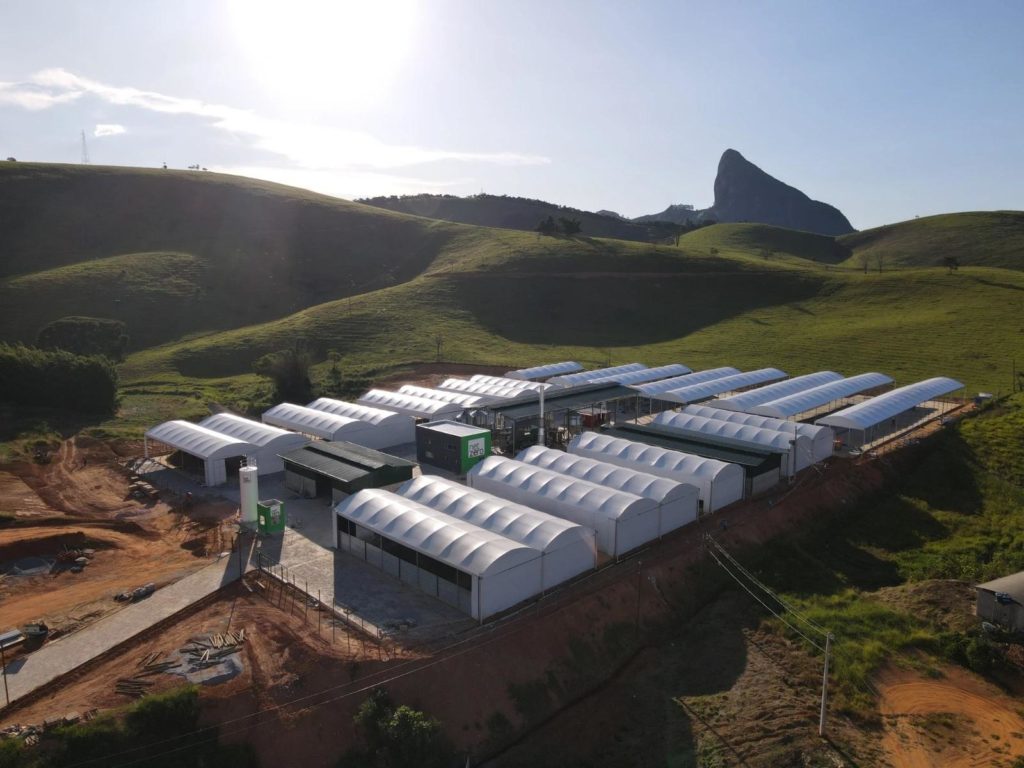
NetZero biochar plant in Lajinha, Brazil. Photo Credit: NetZero
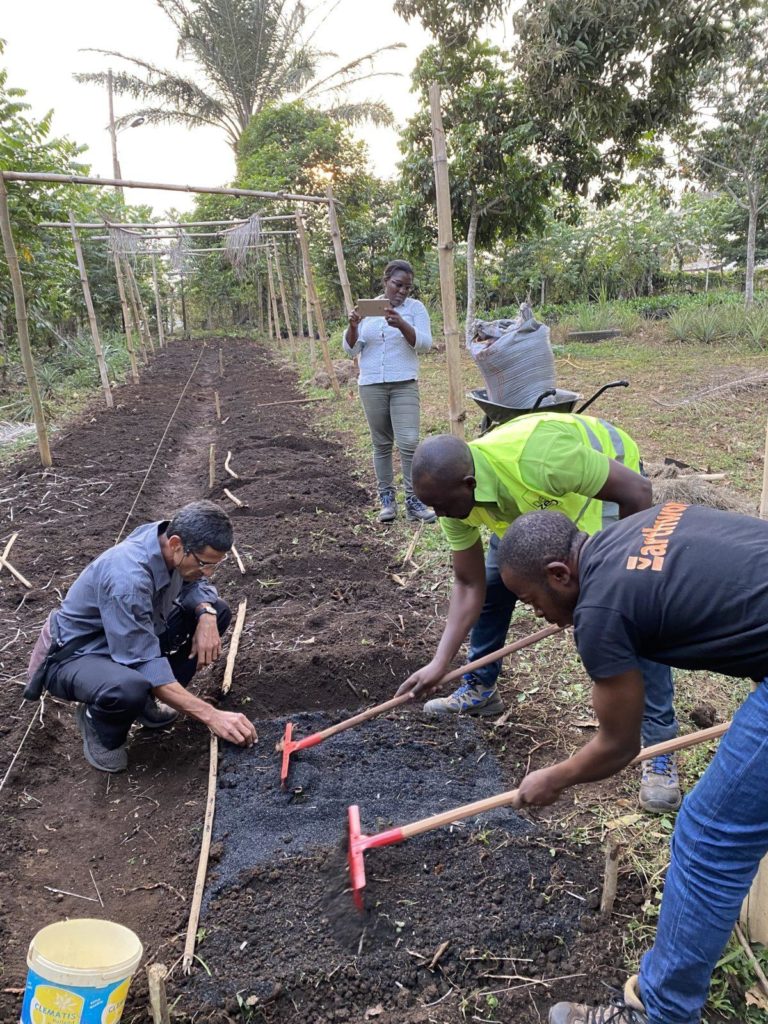
Farmers applying biochar to crops in Cameroon. Photo Credit: Earthworm Foundation
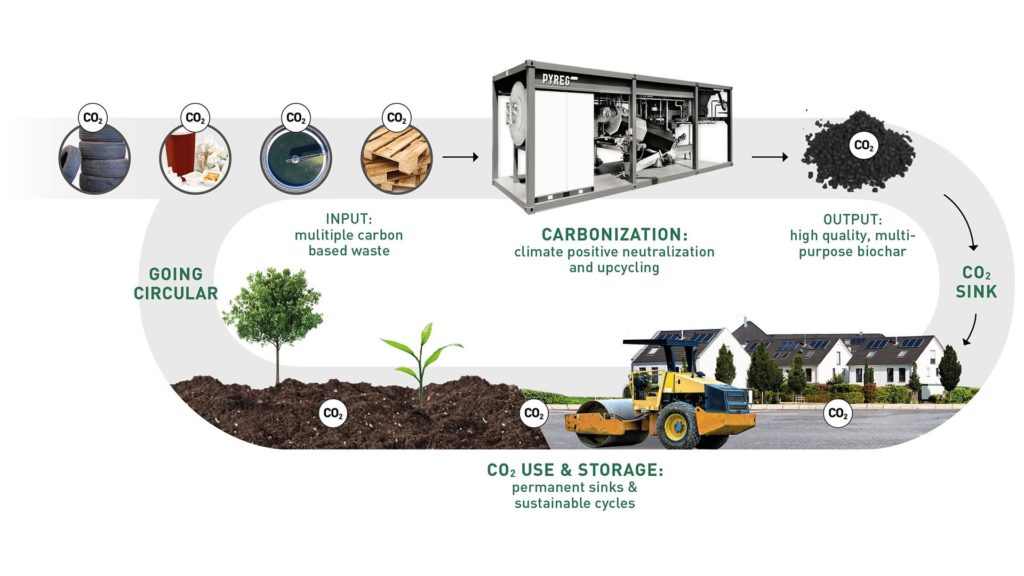
Circular model of biochar production. Photo Credit: Pyreg
Impact Statement
Through its pilot production facility in Cameroon, NetZero’s success has created a huge opportunity to scale systemic impact in both carbon removal and sustainable agriculture.
In the process of carbon removal, biochar serves as an effective solution primarily due to its main chemical component: carbon. This carbon originates from the atmosphere, captured by plants through the process of photosynthesis. During the pyrolysis process, when biochar is incorporated into the soil, this carbon is extracted and stabilized. Importantly, once in the soil, the carbon remains sequestered for extended periods, spanning hundreds of years. In essence, biochar emerges as a long-term and enduring means of removing carbon from the environment.
In addition to carbon removal, NetZero’s end-to-end operations model maximizes environmental and social impact by:
- Reducing the application of synthetic fertilizers which reduces more than proportionately GHG emissions from fertilizer production (CO2) and use (N2O);
- Creating qualified, well paid industrial jobs in rural areas;
- Subsidizing the selling price of biochar for farmers, making it affordable;
- Increasing the income for farmers by using the biochar to improve yields;
- Generating 24/7 stable and renewable electricity for local use.
NetZero’s biochar plays a pivotal role in promoting sustainable agriculture by offering a range of benefits. The application of biochar on agricultural land enhances the soil by acting as a carbon sponge that effectively retains water and nutrients at plant root level, rebalances soil pH, improves soil aeration and increases crop yield for farmers.
From a trading perspective, the utilization of NetZero’s biochar provides significant advantages to buyers of processed crops, cooperatives, and processing facilities. They can source higher-quality products while simultaneously reducing their carbon footprint.
Moreover, biochar aids in reducing the reliance on synthetic fertilizers, presenting the potential for a transition towards 100% organic production. This shift not only helps improve environmental sustainability but also contributes to reducing the carbon footprint of agriculture. By removing carbon from the atmosphere and curbing emissions associated with fertilizer production and use, biochar plays a critical role in mitigating climate change impacts.
As a recipient of the Milestone Award in Elon Musk’s XPRIZE Carbon Removal competition, NetZero’s approach is recognized for its circular win-win model, wherein the benefits extend to various stakeholders in the agricultural chain. This comprehensive utilization of biochar fosters a sustainable and mutually beneficial system for all involved.
NetZero’s model for carbon negative emissions and increased agricultural productivity presents an enormous opportunity to help realize the UN Sustainable Development Goals, namely:
#1: No Poverty (by supporting sustainable livelihoods in rural areas through procurement and partnerships);
#2: Zero Hunger (by improving soil fertility and crop yield, biochar helps to enhance food security and supports efforts to achieve zero hunger);
#7: Affordable and Clean Energy (NetZero’s utilization of biochar production by redirecting gasses for heat and electricity generation aligns with the goal of promoting clean and affordable energy access);
#8: Decent Work and Economic Growth (by creating job opportunities, particularly in rural areas, where biochar production and agricultural benefits are realized);
#9: Industry, Innovation, and Infrastructure (NetZero’s innovative approach to biochar production and its establishment of industrial-scale facilities contribute to advancing industry, innovation, and infrastructure);
#12: Responsible Consumption and Production (NetZero’s circular model and use of waste coffee husks as feedstock align with the goal of responsible consumption and production, reducing waste and utilizing resources efficiently);
#13: Climate Action (providing a negative emission technology that helps remove carbon from the atmosphere, reducing greenhouse gas emissions and mitigating climate change);
#15: Life on Land (enhances soil quality, promotes sustainable agriculture, and helps restore degraded land, supporting biodiversity conservation and land ecosystem health).
Systems Perspective
Biochar is often referred to as a “new” technology in the context of modern climate change mitigation efforts because its potential applications and benefits for carbon removal and sustainable agriculture have gained significant attention and recognition only in recent years. While the practice of making biochar itself is indeed ancient, dating back thousands of years, its integration into contemporary scientific research, technological advancements, and large-scale implementation is relatively new.
The historical use of biochar can be traced back to ancient civilizations such as the Amazonians, who created fertile Terra Preta soils through the application of charred biomass. However, the broader awareness and scientific understanding of biochar’s properties, production techniques, and potential for carbon sequestration have emerged more recently.
The modern interest in biochar as a technology stems from the urgent need to mitigate climate change and find sustainable solutions for agricultural practices. Researchers and experts have recognized biochar’s ability to sequester carbon, enhance soil fertility, improve water retention, and reduce greenhouse gas emissions. These characteristics, combined with its potential for large-scale implementation, make biochar a promising tool for addressing both climate change and sustainable agriculture.
Furthermore, advancements in technology and scientific understanding have enabled a deeper exploration of biochar’s properties and potential applications. With the capacity to offset 12% of global greenhouse gas emissions and offering numerous co-benefits, the integration of modern pyrolysis techniques, improved understanding of soil dynamics, and advanced modeling and measurement tools have contributed to the renewed interest in biochar as a valuable and effective technology for carbon removal.
It is important to note biochar application should be tailored to specific soil types and conditions to maximize its benefits. In certain cases –within temperate climates as highlighted in the case overview– biochar application may have limited effects on soils with already high organic matter content or specific chemical properties. Biochar production also requires a steady supply of biomass feedstock. The availability and sustainability of biomass sources, such as agricultural residues or waste products, may vary regionally and over time and can pose a challenge to scaling up operations in certain areas.
Another caveat is that the production of biochar involves high thermal energy utilization, which can result in the release of greenhouse gas emissions during the pyrolysis process. The energy-intensive nature of biochar production should be carefully managed to minimize emissions and ensure a net carbon-negative process.
NetZero’s utilization of the pyrolysis process in biochar production suggests its durability, allowing it to remain in the soil for hundreds of years. However, while biochar has the capacity to sequester carbon in the soil for extended periods, its carbon sequestration potential may vary depending on factors such as soil type, climate conditions, and management practices. The actual amount of carbon sequestered can be influenced by these variables. The long-term metrics of biochar on soil health, nutrient cycling, and microbial activity require further research.
Although predominantly used at a local level, biochar can have a global impact, generating substantial socioeconomic advantages. In countries like Cameroon, where rural communities face socioeconomic challenges exacerbated by climate change, NetZero’s biochar production provides a timely solution for stability, growth and resilience across environmental, economic and social domains.
NetZero’s objective to scale up biochar production in Cameroon, Brazil, and other tropical countries, and produce larger quantities represents a commendable step forward. Global stakeholders should recognize it as a unique opportunity to invest in the environment and the future, contributing to a sustainable and thriving planet.
Links and Contact Information
- NetZero Website: https://netzero.green/en/biochar/
LinkedIn Profile of NetZero Founders
- Axel Reinaud: https://www.linkedin.com/in/axelreinaud/
- Olivier Trinaud: https://www.linkedin.com/in/oreinaud/
- Pedro de Figueiredo: https://www.linkedin.com/in/pedro-de-figueiredo-665b87128/
- Aime Njiakin: https://www.linkedin.com/in/aim%C3%A9-njiakin-97338068/
Article by: 4Revs Reseacher Nkechika Ibe | July, 2023


